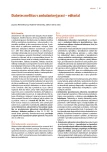Compliance and individualized therapeutic targets in patients with DM2T treated with gliptins in monotherapy or in combination with other antidiabetic drugs: CITADELA Study
Authors:
Zuzana Némethyová 1; Dagmar Bucková 2; Miroslav Helbich 3
Authors‘ workplace:
Dia centrum plus, s. r. o., Bratislava
1; Novartis Slovakia s. r. o., Bratislava
2; Caldera s. r. o, Banská Štiavnica
3
Published in:
Forum Diab 2015; 4(2): 129-134
Category:
Main Theme: Original Paper
Overview
Introduction:
The recommendations of ADA/EASD professional associations on the management of hyperglycemia in patients with type 2 diabetes mellitus from 2015 emphasize that the care should be adapted to the needs of specific groups of patients. The setting of individual therapeutic goals and the level of their fulfilment in the treatment with gliptins in clinical practice had not been monitored until now in Slovakia.
The aim of the study:
The primary aim was to establish the achievement of an individual therapeutic goal of glycemic compensation (HbA1c) in predefined therapeutic regimens containing gliptins in patients with type 2 diabetes mellitus in Slovakia. The secondary aims consisted in monitoring the ways in which demographic characteristics and the presence of other vascular complications affected the reaching of an individual target HbA1c and compensation of the intraday blood glucose variability assessed by means of MAGE algorithm from the 7-point large glycemic profile obtained within domestic monitoring of glycemia.
Methods:
CITADELA (TArgets for T2D patiEnt’s using gLiptins Alone or as add on therapy) was a 6-month prospective observation study which monitored 615 patients from 41 centres in the Slovak Republic. The cohort included adult patients with type 2 diabetes mellitus (DM) whose metabolic compensation was insufficient (glycosylated haemoglobin (HbA1c) was within the range of 7% – 11%), and whose initial therapy was intensified by gliptins depending on the physician‘s discretion and based on normal clinical practice. The indicators of glycemic compensation and a comprehensive health status of the patient were recorded at three patient visits.
Results:
The average HbA1c level decreased during the course of the study from 8.79% ± 1.26% on entering the study to 7.89%± 1.16% after 3 months, and to 7.57% ± 1.1% after 6 months of therapy, this indicating a positive effect of the treatment with gliptins (p < 0.0001). The average individual target levels expected by physicians for HbA1c were 7.6% after 3rd month and 7.1% after 6th month of treatment. Overall 40.5% of the patients achieved these individually set target HbA1c levels after 3 months and 31.4% after 6 months of treatment. The average daily glucose levels decreased from 10.3 ± 2.2 mmol/l on entering the study to 8.7 ± 1.7 after 3 months and decreased to 8.4 ± 1.6 after 6 months of treatment (p<0.001). Low daily glycemic variability (MAGE≤ 2.8) was observed in 50% of the patients at the time of their inclusion in the study, in 70% after 3 months of treatment and in up to 79% of the patients after 6 months of treatment (p<0.001). It can be definitely stated that the compensation of intraday blood glucose variability significantly increased in the course of the monitoring.
Conclusion:
The therapy with gliptins reached the reduction in HbA1c and the intraday glycemic variability in all the predefined therapeutic regimens. The comparison of the results with the expected individual targets of glycemic compensation leads to the conclusion that the goals established by physicians in the clinical practice are more ambitious than the change actually attained.
Key words:
type 2 diabetes mellitus – oral antidiabetic drugs – gliptins
Sources
1. Guariguata L, Whiting DR, Hambleton I et al. Global estimates of diabetes prevalence for 2013 and projections for 2035. Diabetes Res Clin Pract 2014; 103(2): 137–149.
2. Inzucchi SE, Bergenstal RM, Buse JB et al. Management of hyperglycemia in type 2 diabetes, 2015: a patient-centered approach. Update to a Position statement of the American Diabetes Association (ADA) and the European Association for the Study of Diabetes (EASD). Diabetes Care 2015; 38(1): 140–149. Diabetologia 2015; 58(3): 429–442. Dostupné z DOI: <http://dx.doi.org/10.1007/s00125–014–3460–0>.
3. Ahrén B, Landin-Olsson M, Jansson PA et al. (2004). Inhibition of dipeptidyl peptidase-4 reduces glycemia, sustains insulin levels, and reduces glucagon levels in type 2 diabetes. J Clin Endocrinol Metab 2004; 89(5): 2078–2084.
4. Weiss D. ADA Issues New Type 2 Diabetes Treatment Guidelines. Dostupné z WWW: <http://www.pharmacytimes.com/news/ADA-Issues-New-Type-2-Diabetes-Treatment-Guidelines#sthash.wrnxmCxD.dpuf>.
5. Martin Haluzík. Glykemická variabilita: nový parametr kompenzace diabetu? Forum Diab 2012; 1(2–3): 71–76.
6. Hill NR, Oliver NS, Choudhary P et al. Normal reference range for mean tissue glucose and glycemic variability derived from continuous glucose monitoring for subjects without diabetes in different ethnic groups. Diabetes Technol Ther 2011; 13(9): 921–928.
7. Siegelaar SE, Holleman F, Hoekstra JB et al. Glucose variability; does it matter? Endocr Rev 2010; 31 : 171–182.
8. Perez Garcia M, Figueras A. The lack of knowledge about the voluntary reporting system of adverse drug reactions as a major cause of underreporting: direct survey among health professionals. Pharmacoepidemiol Drug Saf 2011; 20(12): 1295–1302.
9. Hazell L, Shakir SA. Under-reporting of adverse drug reactions: a systematic review. Drug Saf 2006; 29(5): 385–396.
Labels
Diabetology Endocrinology Internal medicineArticle was published in
Forum Diabetologicum

2015 Issue 2
Most read in this issue
- Acute complications of diabetes mellitus from out-patient department perspective
- Dermatologic manifestations of diabetes
- The most common gynecologic problems in diabetic women
- Chronical diabetic complications from point of view of modern diabetology
